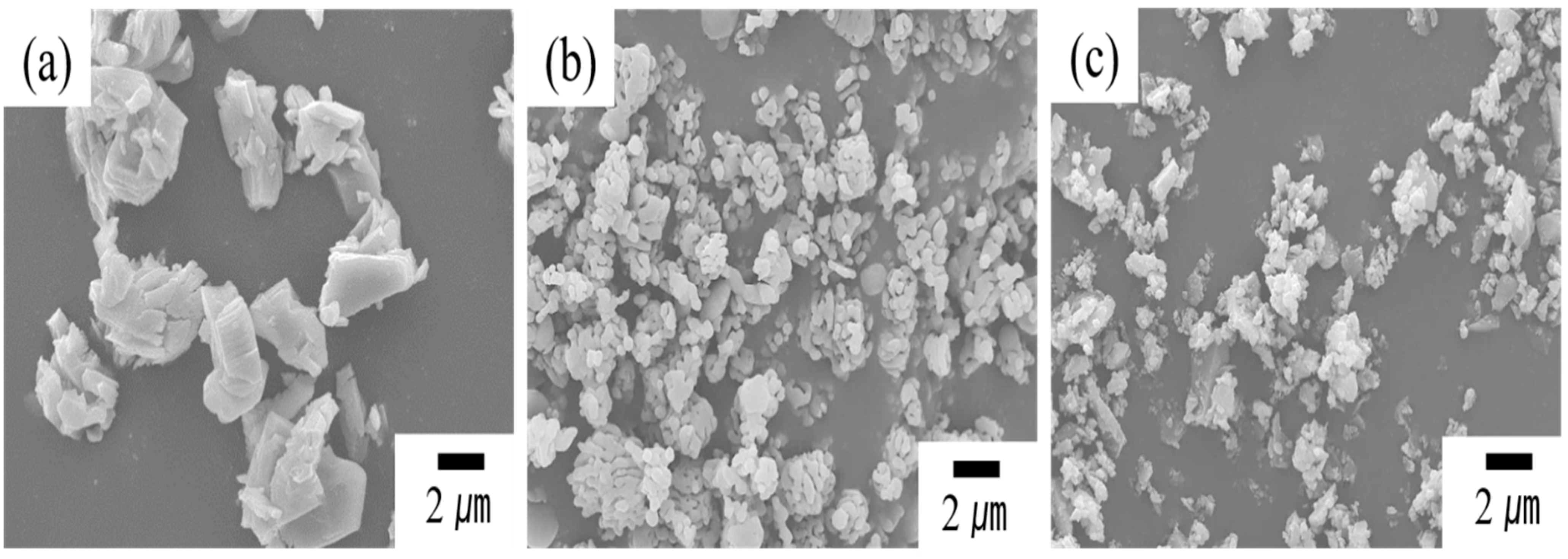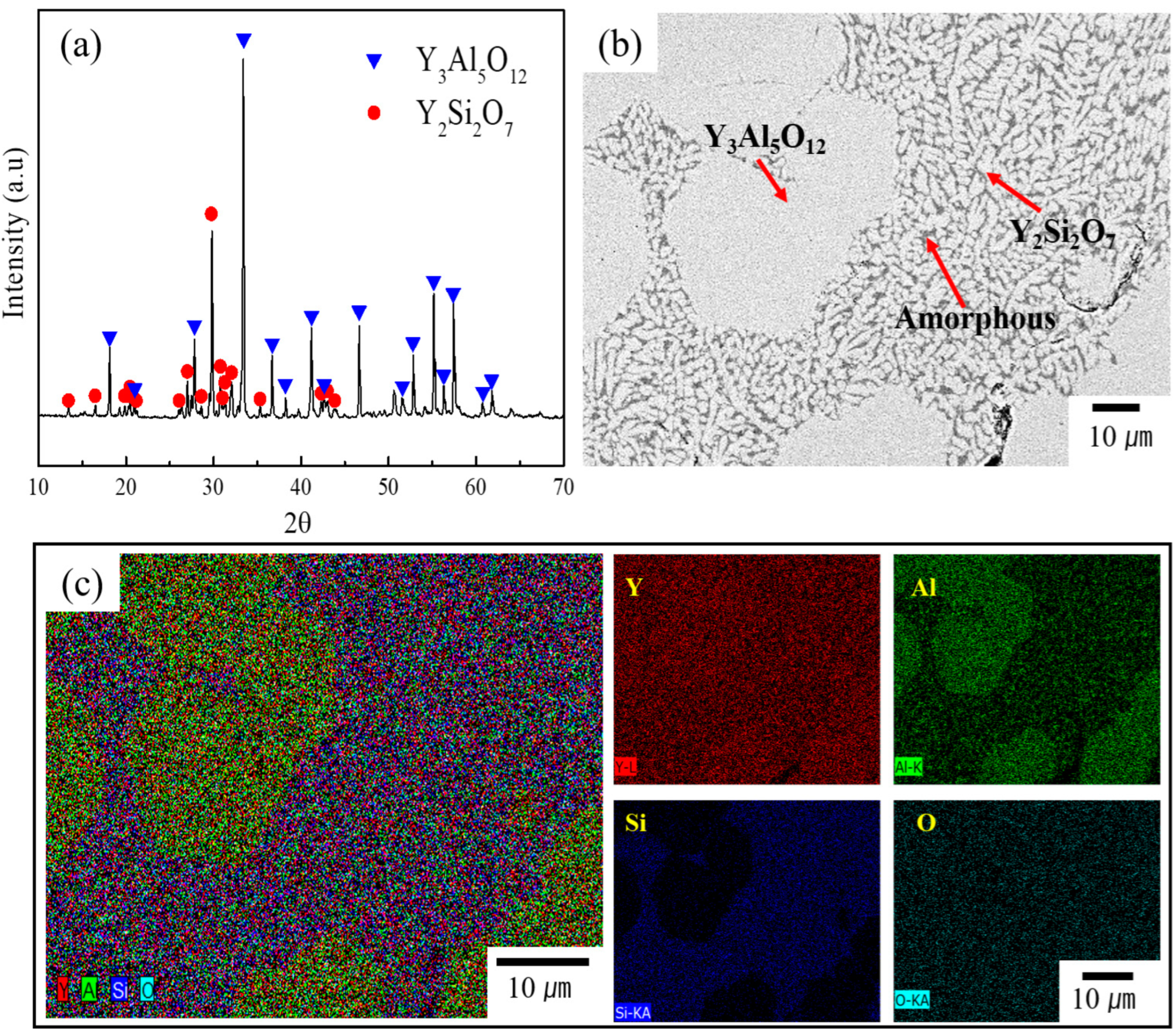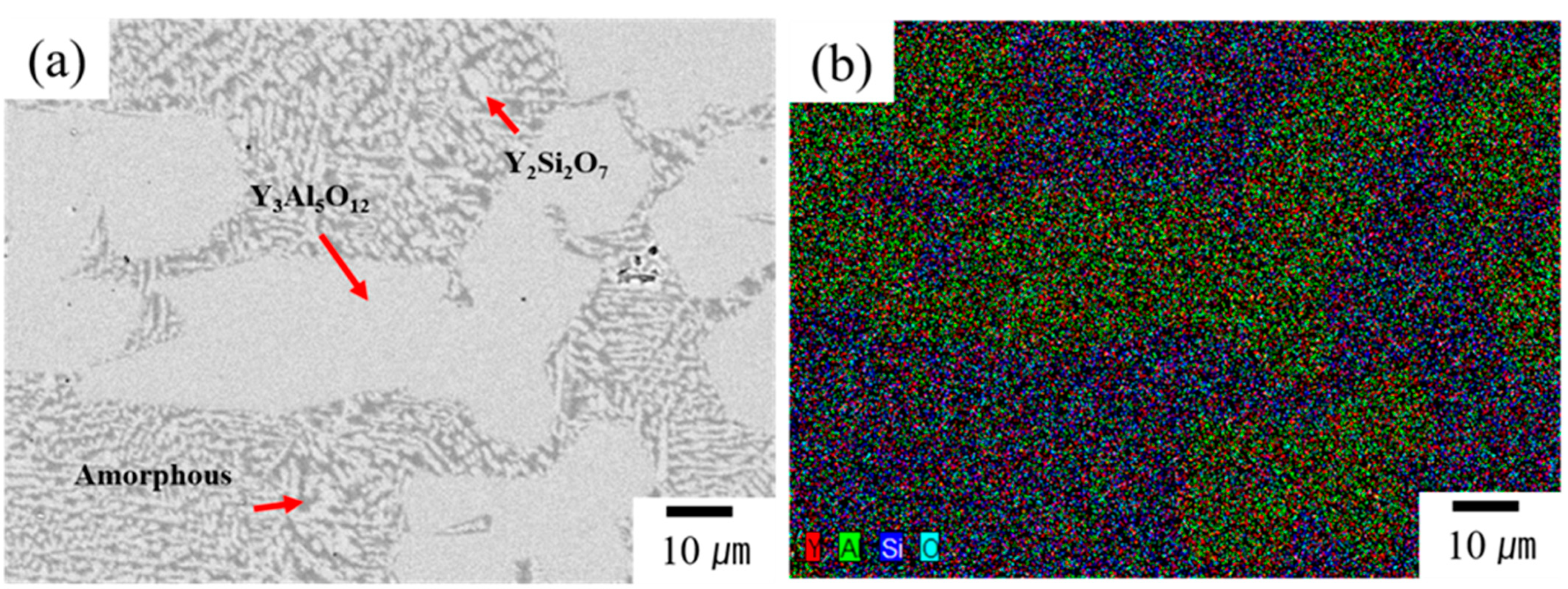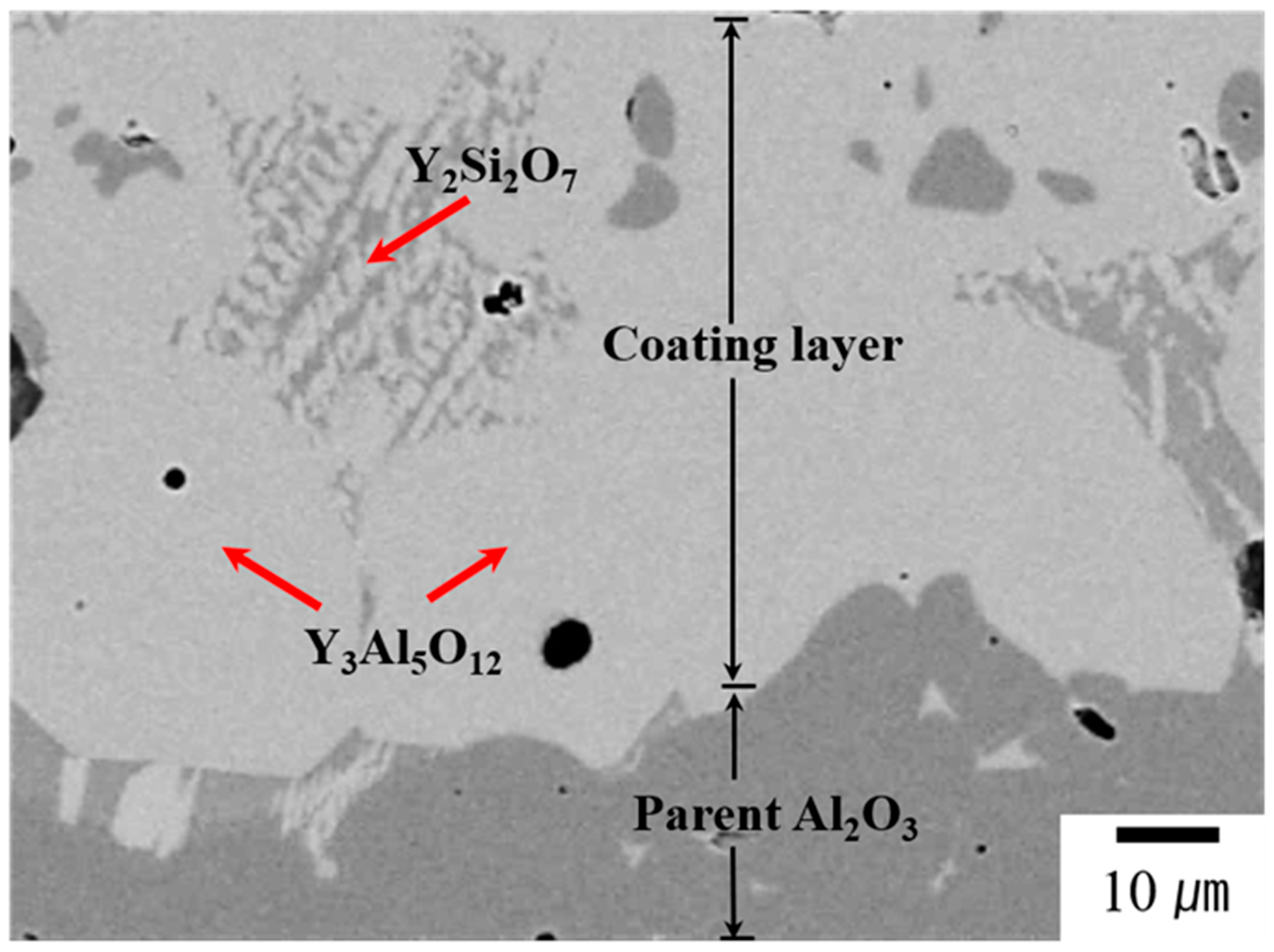Fabrication, Microstructure and Plasma Resistance Behavior of Y–Al–Si–O (YAS) Glass-Ceramics Coated on Alumina Ceramics
Abstract
:1. Introduction
2. Materials and Methods
3. Results and Discussion
4. Conclusions
Supplementary Materials
Author Contributions
Funding
Institutional Review Board Statement
Informed Consent Statement
Data Availability Statement
Conflicts of Interest
References
- Abe, H.; Yoneda, M.; Fujiwara, N. Developments of Plasma Etching Technology for Fabricating Semiconductor Devices. Jpn. J. Appl. Phys. 2008, 47, 1435–1455. [Google Scholar] [CrossRef]
- Banna, S.; Agarwal, A.; Cunge, G.; Darnon, M.; Pargon, E.; Joubert, O. Pulsed High-density Plasmas for Advanced Dry Etching Processes. J. Vac. Sci. Technol. A 2012, 30, 040801. [Google Scholar] [CrossRef]
- Economou, D.J. Pulsed Plasma Etching for Semiconductor Manufacturing. J. Phys. D Appl. Phys. 2014, 47, 303001. [Google Scholar] [CrossRef]
- Chun, I.; Efremov, A.; Yeom, G.Y.; Kwon, K.-H. A comparative study of CF4/O2/Ar and C4F8/O2/Ar Plasmas for Dry Etching Applications. Thin Solid Film. 2015, 579, 136–143. [Google Scholar] [CrossRef]
- Oehrlein, G.S.; Brandstadter, S.M.; Bruce, R.L.; Chang, J.P.; DeMott, J.C.; Donnelly, V.M.; Dussart, R.; Fischer, A.; Gottscho, R.A.; Hamaguchi, S.; et al. Future of Plasma Etching for Microelectronics: Challenges and Opportunities. J. Vac. Sci. Technol. B 2024, 42, 041501. [Google Scholar] [CrossRef]
- Choi, J.H.; Im, W.B.; Kim, H.-J. Plasma Resistant Glass (PRG) for Reducing Particulate Contamination During Plasma Etching in Semiconductor Manufacturing: A Review. Mater. Today Commun. 2023, 34, 105267. [Google Scholar] [CrossRef]
- Kim, D.-M.; Kim, K.-B.; Yoon, S.-Y.; Oh, Y.-S.; Kim, H.-T.; Lee, S.-M. Effect of Artificial Pores and Purity on the Erosion Behaviors of Polycrystalline Al2O3 Ceramics under Fluorine Plasma. J. Ceram. Soc. Jpn. 2009, 117, 863–867. [Google Scholar] [CrossRef]
- Kasashima, Y.; Tabaru, T.; Matsuda, O.; Motomura, T. Investigation of the Relationship between Plasma Etching Characteristics and Microstructures of Alumina Ceramics for Chamber Parts. Jpn. J. Appl. Phys. 2019, 58, 041001. [Google Scholar] [CrossRef]
- Jang, M.-R.; Paek, Y.-K.; Lee, S.-M. Plasma Resistance and Etch Mechanism of High Purity SiC under Fluorocarbon Plasma. J. Korean Ceram. Soc. 2012, 49, 328–332. [Google Scholar] [CrossRef]
- Garcia-Rosales, C. Erosion Processes in Plasma-wall Interactions. J. Nucl. Mater. 1994, 211, 202–214. [Google Scholar] [CrossRef]
- Wang, X.; Lee, H.; Nam, S.K.; Kushner, M.J. Erosion of Focus Rings in Capacitively Coupled Plasma Etching Reactors. J. Vac. Sci. Technol. A 2021, 39, 063002. [Google Scholar] [CrossRef]
- Song, J.B.; Kim, J.T.; Oh, S.G.; Yun, J.Y. Contamination Particles and Plasma Etching Behavior of Atmospheric Plasma Sprayed Y2O3 and YF3 Coatings under NF3 Plasma. Coatings 2019, 9, 102. [Google Scholar] [CrossRef]
- Ito, N.; Moriya, T.; Uesugi, F.; Matsumoto, M.; Liu, S.; Kitayama, Y. Reduction of Particle Contamination in Plasma-etching Equipment by Dehydration of Chamber Wall. Jpn. J. Appl. Phys. 2008, 47, 3630–3634. [Google Scholar] [CrossRef]
- So, J.; Kim, M.; Kwon, H.; Maeng, S.; Choi, E.; Chung, C.-W.; Yun, J.-Y. Investigation of Contamination Particles Generation and Surface Chemical Reactions on Al2O3, Y2O3, and YF3 Coatings in F-based Plasma. Appl. Surf. Sci. 2023, 629, 157367. [Google Scholar] [CrossRef]
- Kim, C.S.; Kim, M.J.; Cho, H.; Park, T.-E.; Yun, Y.-H. Fabrication and Plasma Resistance of Y2O3 Ceramics. Ceram. Int. 2015, 41, 12757–12762. [Google Scholar] [CrossRef]
- Ashizawa, H.; Yoshida, K. Effect of the Microstructures of Yttria Ceramics on Their Plasma Corrosion Behavior. Ceram. Int. 2019, 45, 21162–21167. [Google Scholar] [CrossRef]
- Kim, D.-M.; Oh, Y.-S.; Kim, S.; Kim, H.-T.; Lim, D.-S.; Lee, S.-M. The Erosion Behaviors of Y2O3 and YF3 Coatings under Fluorocarbon Plasma. Thin Solid Film. 2011, 519, 6698–6702. [Google Scholar] [CrossRef]
- Shiba, Y.; Teramoto, A.; Goto, T.; Kishi, Y.; Shirai, Y.; Sugawa, S. Stable Yttrium Oxyfluoride Used in Plasma Process Chamber. J. Vac. Sci. Technol. A 2017, 35, 021405. [Google Scholar] [CrossRef]
- Miyashita, K.; Tsunoura, T.; Yoshida, K.; Yano, T.; Kishi, Y. Fluorine and Oxygen Plasma Exposure Behavior of Yttrium Oxyfluoride Ceramics. Jpn. J. Appl. Phys. 2019, 58, SEEC01. [Google Scholar] [CrossRef]
- Qin, X.; Zhou, G.; Yang, H.; Wong, J.I.; Zhang, J.; Luo, D.; Wang, S.; Ma, J.; Tang, D. Fabrication and Plasma Resistance Properties of Transparent YAG ceramics. Ceram. Int. 2012, 38, 2529–2535. [Google Scholar] [CrossRef]
- Cao, Y.-C.; Zhao, L.; Luo, J.; Wang, K.; Zhang, B.-P.; Yokota, H.; Ito, Y.; Li, J.-F. Plasma Etching Behavior of Y2O3 Ceramics: Comparative Study with Al2O3. Appl. Surf. Sci. 2016, 366, 304–309. [Google Scholar] [CrossRef]
- Park, S.H.; Kim, K.E.; Hong, S.J. Surface Analysis of Chamber Coating Materials Exposed to CF4/O2 Plasma. Coatings 2021, 11, 105. [Google Scholar] [CrossRef]
- Lee, S.; Lee, J.; Kim, W.; Hwang, N.-M. Plasma Etching Behavior of YOF Coating Deposited by Suspension Plasma Spraying in Inductively Coupled CHF3/Ar Plasma. Coatings 2020, 10, 1023. [Google Scholar] [CrossRef]
- Lin, T.-K.; Wang, W.-K.; Huang, S.-Y.; Tasi, C.-T.; Wuu, D.-S. Comparison of Erosion Behavior and Particle Contamination in Mass-Production CF4/O2 Plasma Chambers Using Y2O3 and YF3 Protective Coatings. Nanomaterials 2017, 7, 183. [Google Scholar] [CrossRef] [PubMed]
- Lee, Y.; Yeom, H.; Choi, D.; Kim, S.; Lee, J.; Kim, J.; Lee, H.; You, S. Database Development of SiO2 Etching with Fluorocarbon Plasmas Diluted with Various Noble Gases of Ar, Kr, and Xe. Nanomaterials 2022, 12, 3828. [Google Scholar] [CrossRef] [PubMed]
- Jung, Y.S.; Min, K.W.; Choi, J.H.; Yoon, J.S.; Im, W.B.; Kim, H.-J. Plasma-resistant Characteristics According to Sintering Conditions of CaO–Al2O3–SiO2 Glass Coating layer. J. Korean Ceram. Soc. 2022, 59, 86–93. [Google Scholar] [CrossRef]
- Choi, S.; Jeong, D.-Y.; Kim, H. Plasma Resistance of Quartz with a Glass Coating Layer by Aerosol Deposition. Adv. Appl. Ceram. 2018, 117, 328–333. [Google Scholar] [CrossRef]
- Kreethi, R.; Hwang, Y.-J.; Lee, H.-Y.; Park, J.-H.; Lee, K.-A. Stability and Plasma Etching Behavior of Yttrium-based Coatings by Air Plasma Spray Process. Surf. Coat. Technol. 2023, 454, 129182. [Google Scholar] [CrossRef]
- Iwasawa, J.; Nishimizu, R.; Tokita, M.; Kiyohara, M.; Uematsu, K. Plasma-resistant Dense Yttrium Oxide Film Prepared by Aerosol Deposition Process. J. Am. Ceram. Soc. 2007, 90, 2327–2332. [Google Scholar] [CrossRef]
- Niinisto, J.; Putkonen, M.; Niinisto, L. Processing of Y2O3 Thin Films by Atomic Layer Deposition from Cyclopentadienyl-type Compounds and Water as Precursors. Chem. Mater. 2004, 16, 2953–2958. [Google Scholar] [CrossRef]
- Banal, R.; Kimura, T.; Goto, T. High Speed Deposition of Y2O3 Films by Laser Assisted Chemical Vapor Deposition. Mater. Trans. 2005, 46, 2114–2116. [Google Scholar] [CrossRef]
- Park, E.K.; Lee, H.-K. Fabrication of Plasma Resistant Y2O3-Al2O3-SiO2 Coating Ceramics by Melt-Coating Method. Korean J. Mater. Res. 2020, 30, 359–368. [Google Scholar] [CrossRef]
- Mlainverni, C.; Salvo, M.; Zietara, M.; Cempura, G.; Kruk, A.; Maier, J.; Prentice, C.; Farnham, M.; Casalengo, V. A Yttrium Aluminosilicate Glass-Ceramic to Join SiC/SiC Composites. J. Eur. Ceram. Soc. 2024, 44, 3579–3587. [Google Scholar] [CrossRef]
- Park, J.; Choi, J.H.; Na, H.; Kim, H.J. Effect of CaF2 on Fluorocarbon Plasma Resistance and Thermal Properties of CaO-Al2O3-SiO2 Glasses. J. Asian Ceram. Soc. 2021, 9, 311–317. [Google Scholar] [CrossRef]
- Gao, C.; Zhao, X.; Li, B. Influence of Y2O3 on Microstructure, Crystallization, and Properties of MgO-Al2O3-SiO2 Glass-Ceramics. J. Non-Cryst. Solids 2021, 560, 120728. [Google Scholar] [CrossRef]
- Na, H.; Park, J.; Choi, S.C.; Kim, H.J. The Effect of Composition of Plasma Resistance of CaO–Al2O3–SiO2 Glasses under Fluorocarbon Plasma with Ar+. Appl. Surf. Sci. 2019, 476, 663–667. [Google Scholar] [CrossRef]
- Ma, Y.; Guo, C.; Cui, Y.; Yang, S.; Meng, X.; Kou, S.; Luan, C.; Deng, J.; Fan, S. Enhanced Water-Oxygen Corrosion Resistance of SiC/SiC Composites at 1350 °C via Single-Layer Y-Al-Si-O Glass-Ceramics Environmental Barrier Coatings. J. Eur. Ceram. Soc. 2024, 44, 116728. [Google Scholar] [CrossRef]
- Lee, J.; Kim, D.; Lee, S.; Kim, H. Effect of Rare-earth Elements on the Plasma Etching Behavior of the RE-Si-Al-O Glasses. J. Non-Cryst. Solids 2012, 358, 898–902. [Google Scholar] [CrossRef]
- Fabrichnaya, O.; Seifert, H.J.; Weiland, R.; Ludwig, T.; Aldinger, F.; Navrotsky, A. Phase Equilibria and Thermodynamics in the Y2O3–Al2O3–SiO2 System. Int. J. Mater. Res. 2001, 92, 1083–1097. [Google Scholar]
- Bondar, I.A.; Galakhov, F.Y. Phase Equilibria in the System Y2O3-Al2O3-SiO2. Russ. Chem. Bull. 1964, 13, 1231–1232. [Google Scholar] [CrossRef]
- Sadiki, N.; Coutures, J.P.; Fillet, C.; Dussossoy, J.L. Crystallization of Lanthanum and Yttrium Aluminosilicate Glasses. J. Nucl. Mater. 2006, 348, 70–78. [Google Scholar] [CrossRef]
- Parmentier, J.; Bodart, P.R.; Audoin, L.; Massouras, G.; Thompson, D.P.; Harris, R.K.; Goursat, P.; Besson, J.-L. Phase Transformations in Gel-Derived and Mixed-Powder-Derived Yttrium Disilicate, Y2Si2O7, by X-Ray Diffraction and 29Si MAS NMR. J. Solid State Chem. 2000, 149, 16–20. [Google Scholar] [CrossRef]
- Kolitsch, U.; Seifert, H.J.; Ludwig, T.; Aldinger, F. Phase Equilibria and Crystal Chemistry in the Y2O3–Al2O3–SiO2 System. J. Mater. Res. 1999, 14, 447–455. [Google Scholar] [CrossRef]
- Ahmad, S.; Ludwig, T.; Herrmann, M.; Mahmoud, M.M.; Lippmann, W.; Seifert, H.J. Phase Evaluation During High Temperature Long Heat Treatments in the Y2O3–Al2O3–SiO2 system. J. Eur. Ceram. Soc. 2014, 34, 3835–3840. [Google Scholar] [CrossRef]
- Kolitsch, U.; Scifert, H.J.; Aldinger, F. Phase Relationships in the Systems RE2O3-Al2O3-SiO2 (RE = rare earth element, Y, and Sc). J. Phase Equilibria 1998, 19, 426–433. [Google Scholar] [CrossRef]
- Zhang, Y.; Navrotsky, A. Thermochemistry of Glasses in the Y2O3-Al2O3-SiO2 System. J. Am. Ceram. Soc. 2003, 86, 1727–1732. [Google Scholar] [CrossRef]
- Shah, B.; Kakumanu, V.K.; Bansal, A.L. Analytical Techniques for Quantification of Amorphous/Crystalline Phases in Pharmaceutical Solids. J. Pharm. Sci. 2006, 95, 1641–1665. [Google Scholar] [CrossRef]
- Anantharaman, S.B.; Rajkumar, V.B.; Raghunandan, S.; Kumer, K.C.H.; Kumar, R.S. Role of Thermodynamic Miscibility Gaps in Phase Selection in Sol-gel Synthesis of Yttrium Silicates. J. Eur. Ceram. Soc. 2017, 37, 5001–5007. [Google Scholar] [CrossRef]
- Zhao, C.-C.; Kim, E.-B.; Park, Y.-J.; Logesh, G.; Kim, M.-J.; Lee, J.-W.; Ma, H.J.; Kim, H.-N.; Ko, J.-W.; Yoon, S.-Y. Optimization of a TEOS addition on plasma resistance of YAG ceramics. Int. J. Appl. Ceram. Technol. 2024, 21, 3200–3208. [Google Scholar] [CrossRef]
- Zhao, C.-C.; Kim, E.-B.; Park, Y.-J.; Logesh, G.; Kim, M.-J.; Lee, J.-W.; Ma, H.J.; Kim, H.-N.; Ko, J.-W.; Yoon, S.-Y. Optimization of Al-excess nonstoichiometry on the densification and plasma resistance of YAG ceramics. Ceram. Int. 2024, 50, 15325–15332. [Google Scholar] [CrossRef]





| Parameter | Condition |
|---|---|
| Top RF power (W) | 900 |
| Bottom RF power (W) | 200 |
| C4F6 (Sccm) | 30 |
| Ar (Sccm) | 60 |
| O2 (Sccm) | 15 |
| Pressure (mTorr) | 10 |
| Operating time (h) | 1 |
Disclaimer/Publisher’s Note: The statements, opinions and data contained in all publications are solely those of the individual author(s) and contributor(s) and not of MDPI and/or the editor(s). MDPI and/or the editor(s) disclaim responsibility for any injury to people or property resulting from any ideas, methods, instructions or products referred to in the content. |
© 2024 by the authors. Licensee MDPI, Basel, Switzerland. This article is an open access article distributed under the terms and conditions of the Creative Commons Attribution (CC BY) license (https://creativecommons.org/licenses/by/4.0/).
Share and Cite
Park, E.K.; Jang, H.-Y.; Jeon, S.-Y.; Raju, K.; Lee, H.-K. Fabrication, Microstructure and Plasma Resistance Behavior of Y–Al–Si–O (YAS) Glass-Ceramics Coated on Alumina Ceramics. Materials 2024, 17, 4585. https://doi.org/10.3390/ma17184585
Park EK, Jang H-Y, Jeon S-Y, Raju K, Lee H-K. Fabrication, Microstructure and Plasma Resistance Behavior of Y–Al–Si–O (YAS) Glass-Ceramics Coated on Alumina Ceramics. Materials. 2024; 17(18):4585. https://doi.org/10.3390/ma17184585
Chicago/Turabian StylePark, Eui Keun, Hwan-Yoon Jang, Seo-Yeon Jeon, Kati Raju, and Hyun-Kwuon Lee. 2024. "Fabrication, Microstructure and Plasma Resistance Behavior of Y–Al–Si–O (YAS) Glass-Ceramics Coated on Alumina Ceramics" Materials 17, no. 18: 4585. https://doi.org/10.3390/ma17184585








